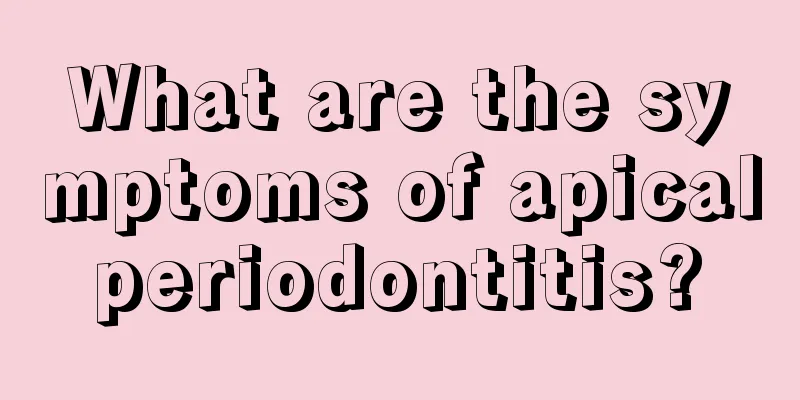What are the symptoms of apical periodontitis?

|
Teeth are very important chewing tools. Without teeth for basic processing of food, it will be difficult for people's stomach and intestines to digest food. Therefore, teeth reduce a large burden on the stomach and intestines. Although teeth are components of bones, they are also prone to pathological reactions. For example, the tissue of the tooth root is very susceptible to inflammation. Let's take a look at the manifestations of apical periodontitis. Acute or chronic inflammation of the tissues around the root apex is called apical periodontitis. When pulpitis develops to the late stage and most or all of the pulp tissue is necrotic, or there is bacterial infection, it causes inflammation of the periapical tissues. When the tooth is hit by a sudden external force, the periapical tissues are also severely traumatized and cause apical periodontitis. Medical-induced infection during treatment can also cause apical periodontitis. Clinical manifestations 1. Acute apical periodontitis In the early stage, the affected tooth will have mild pain. At this time, the pain can be temporarily relieved by clenching the affected tooth. As the inflammation worsens, the patient's teeth will elongate and light tapping of the affected tooth will cause pain. In apical periodontitis, the pain is spontaneous, persistent, and localized, and the patient can clearly point out the affected tooth. If the acute apical periodontitis continues to develop and forms an acute apical abscess, the pain will intensify, the percussion pain will be obvious, and there will be persistent throbbing pain. The pus spreads to the subperiosteum, and the pain and swelling are obvious. Once the pus penetrates the periosteum and reaches the submucosal area, the pain is relieved than before. 2. Chronic apical periodontitis (1) There is generally no spontaneous pain in periapical granulomas. The patient only feels discomfort when chewing, weakness when biting, a strange sensation when percussed, and a feeling of elongation of the affected tooth. At this time, the pulp is mostly necrotic, and acute attacks may occur when the body's resistance is low. (2) There are usually no symptoms of periapical abscess. There may be fistulas in the mucosa of the periapical area of the affected tooth. Granulation tissue often proliferates at the opening of the fistulas, and pus may be discharged from the fistulas. However, due to the drainage of the fistulas, it is not easy to turn into acute inflammation. (3) There are usually no subjective symptoms of apical cysts. The teeth will change color. Dental radiographs can show the cyst at the apex. If the cyst increases in size, it will force the surrounding bone to be absorbed. The mucosa at the apex of the affected tooth will often appear as a semicircular bulge, resembling a ping-pong ball. |
<<: You must know the eight dangers of high blood lipids!
>>: What are the symptoms of mucositis?
Recommend
Benefits of olive oil for weight loss and methods of building a gangster
When losing weight, many women don’t know what ki...
Six secrets of tongue and health: purple tongue due to too much toxin deposits
Traditional Chinese medicine emphasizes the holis...
What to do if you have allergic rhinitis
Allergic rhinitis is an allergic disease. Patient...
What are the causes of prostate cancer?
The causes of prostate cancer are relatively comp...
Life expectancy after surgery for advanced liver cancer
How long can a liver cancer patient generally liv...
What are the symptoms of rheumatic autoimmunity
In life, we often see some people saying that the...
90% of kidney tumors are malignant. Beware of the “terrible” kidney cancer
Although "kidney cancer" does not seem ...
Can apples be put in the refrigerator
Apple is one of the most common fruits. It has th...
What causes aplastic anemia?
In the eyes of most people, anemia is a very comm...
What diseases will you get if you don't eat vegetables
We should eat some vegetables regularly in our da...
The more obvious early symptoms of colorectal cancer
As one of the common digestive tract tumor diseas...
Which department should I go to if I feel stomach discomfort
Almost 70% of people suffer from gastrointestinal...
Understanding what glioma is
The incidence of tumors in modern society is gett...
Some solutions to cold hands and feet
Some friends will have cold hands and feet when t...









